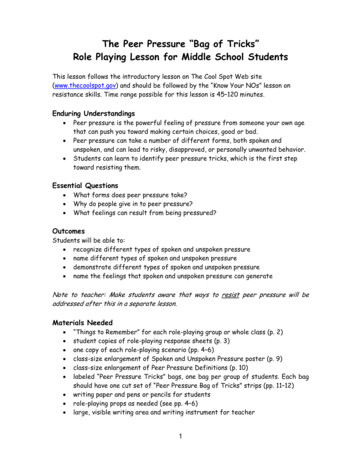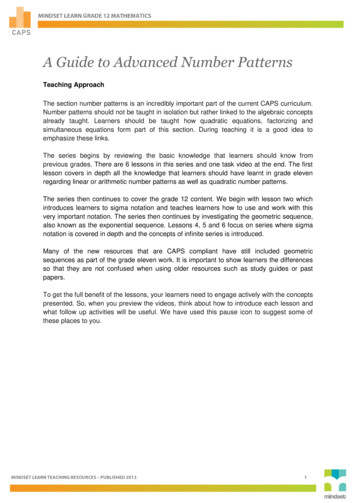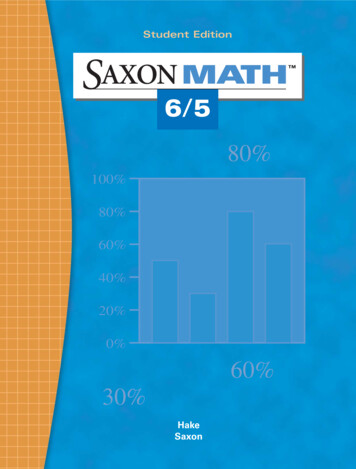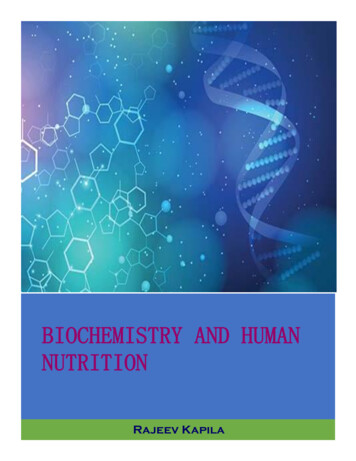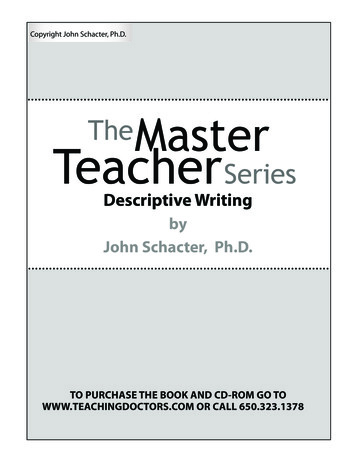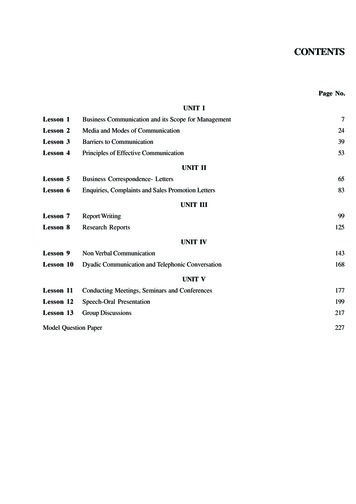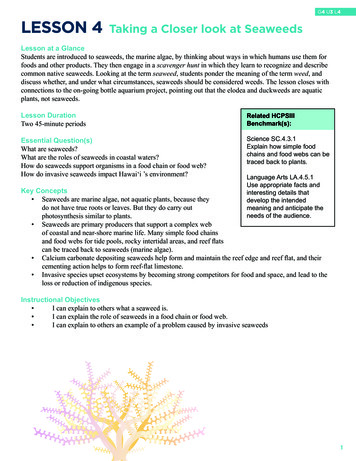
Transcription
G4 U3 L4LeSSon 4Taking a Closer look at SeaweedsLesson at a GlanceStudents are introduced to seaweeds, the marine algae, by thinking about ways in which humans use them forfoods and other products. They then engage in a scavenger hunt in which they learn to recognize and describecommon native seaweeds. Looking at the term seaweed, students ponder the meaning of the term weed, anddiscuss whether, and under what circumstances, seaweeds should be considered weeds. The lesson closes withconnections to the on-going bottle aquarium project, pointing out that the elodea and duckweeds are aquaticplants, not seaweeds.Lesson DurationTwo 45-minute periodsRelated HCPSIIIBenchmark(s):Essential Question(s)What are seaweeds?What are the roles of seaweeds in coastal waters?How do seaweeds support organisms in a food chain or food web?How do invasive seaweeds impact Hawai‘i ’s environment?Science SC.4.3.1Explain how simple foodchains and food webs can betraced back to plants.Language Arts LA.4.5.1Use appropriate facts andinteresting details thatdevelop the intendedmeaning and anticipate theneeds of the audience.Key Concepts Seaweeds are marine algae, not aquatic plants, because theydo not have true roots or leaves. But they do carry outphotosynthesis similar to plants. Seaweeds are primary producers that support a complex webof coastal and near-shore marine life. Many simple food chainsand food webs for tide pools, rocky intertidal areas, and reef flatscan be traced back to seaweeds (marine algae). Calcium carbonate depositing seaweeds help form and maintain the reef edge and reef flat, and theircementing action helps to form reef-flat limestone. Invasive species upset ecosystems by becoming strong competitors for food and space, and lead to theloss or reduction of indigenous species.Instructional Objectives I can explain to others what a seaweed is. I can explain the role of seaweeds in a food chain or food web. I can explain to others an example of a problem caused by invasive seaweeds1
G4 U3 L4Assessment ToolsBenchmark Rubric:TopicBenchmark SC.4.3.1RubricAdvancedProficientCompare theExplain how bothcharacteristics ofsimple food chainssimple food chains with and food webs can bethose of food webstraced back to plantsTopicBenchmark LA.4.5.1RubricAdvancedUse appropriate factsand interesting detailsthat creatively developthe intended meaningand clearly anticipatethe needs of theaudienceProficientUse appropriate factsand interesting detailsthat develop theintended meaning andanticipate the needs ofthe audienceCycles of Matter and EnergyExplain how simple food chains and food webscan be traced back to plantsPartially ProficientNoviceDescribe how simple Recognize that simplefood chains or foodfood chains or foodwebs can be tracedwebs can be tracedback to plantsback to plantsMeaningUse appropriate facts and interesting details thatdevelop the intended meaning and anticipate theneeds of the audiencePartially ProficientUse some trivial factsand obvious detailsthat relate to but do notdevelop the intendedmeaning or anticipatethe needs of theaudienceNoviceUse inappropriate factsand irrelevant detailsthat do not develop theintended meaning oranticipate the needs ofthe audienceAssessment/Evidence PiecesLesson Seaweed Scavenger Hunt student worksheetMaterials NeededTeacher NoneClass Research materials(books and access to the Internet)Group Variety (at least five differentspecies) of seaweedsSeaweed ScavengerHunt worksheetsStudent Instructional ResourcesStudent Worksheet: Seaweed Scavenger HuntTeacher Answer Key: Seaweed Scavenger HuntVariety of vascular plants (at least five species) such as plumeria, ferns, hibiscus, or any treeSupplemental Resource: Aquatic Food Chains Interactive Game (CD-ROM)2None
G4 U3 L4Student Vocabulary Wordsendemic: native to, and only found in a particular region.indigenous species: species that are native, or occur naturally in a region.introduced species: a species that is not native or indigenous to a given place or area, and that has beenaccidentally or deliberately transported to this new location by human activity.invasive species: species that enter into new ecosystems and spread, causing damage to native species and theirhabitats (no natural predator).native species: species that are naturally found in an area or habitat; not introduced by humans.Lesson PlanLesson Preparation Review the Science Background provided in the unit overview. Preview and make copies of Student Worksheet Seaweed Scavenger Hunt, one per student. Gather materials and resources, and reserve the computer lab and research areas for students.I.SeaweedsA. As a way to motivate students’ attention on the topic of seaweeds, ask how many of the studentsin the class have eaten or used seaweeds recently. Ask them to give you some examples, and list these onthe board.1) Anticipate that in Hawai‘i , many students are familiar with eating food recipes using seaweeds,including ogo (limu) Hawaiian dishes, or Japanese sushi and nori.2) Also explain that seaweed extracts are used as gels and thickening agents. (Show pictures or realexamples of items such ice cream, whipped cream, hair gel, and toothpaste.) Both carrageen andagar are edible extracts made from seaweed. (Some students may be familiar with the term agar,which is listed in some local agar recipes.)3) Explain that in this lesson, the class will be investigating the seaweeds. Without going intodetails, tell students that scientists call the seaweeds algae, and that Hawaiians call them limu.B. If possible, have one or more samples of fresh seaweeds available for students to examine. If you cannotcollect fresh seaweeds, fresh limu are often available in supermarkets. (For example, local recipes suchas poke often use limu manauea, a type of Gracilaria that is often called by its Japanese name, ogo.)II.What do we know about seaweeds?A. Develop a KWL chart with the students.1) List what the students know, or think they know, in the left column (K). Later in the lesson, havethe class return to this list to check the statements.2) Have students make a list of questions concerning what they want to learn for the middle column(W). Prompt students, as needed, to ask such questions as:a. What is seaweed?Explain that seaweeds are marine algae. They are not considered plants becausethey lack true roots, stems, and leaves.b. Are the elodea and duckweed in the bottle aquariums seaweeds?Explain to students that the elodea and duckweeds are not seaweeds because they haveroots and produce flowers as well as live in freshwater. They are examples of aquaticplants.c. Where do seaweeds grow?d. How do they grow?e. What animals depend on them?3
G4 U3 L4III.Seaweed Scavenger HuntA. Divide the class into groups of two or three. Distribute the scavenger hunt worksheets. Explain that theyare going on a scavenger hunt to find information about seaweeds. Have students assist in establishingthe scavenger hunt rules and timelines.B. Have each group choose 1 or 2 seaweeds from the list on their worksheet. Instruct the students that theymay use either Internet resources or reference books to find their seaweed information. Write on theboard a few suggested websites that might help from the list below.Websites useful for this activity include:www.Hawaii .edu/reefalgae/default.htm Click on Native Algae, and then click on ReefWatchers Field Guide to Alien and Native Hawaiian Marine Algae and scroll down.http://www.waquarium.org/ ds0909.pdfC. Compile all the group’s findings into a class matrix table. (NOTE:You may want to create a large matrixon butcher paper, the chalk board or on an overhead for the students to see.) Then begin a discussionwith the students’ about their research and findings.IV. Seaweed in a Marine Food ChainA. This “A” is an optional step: What is a weed? Ask students to come up with a definition. Here studentsmight want to look up the definition. Simple definitions include a plant that is undesirable. Brieflydiscuss weeds that grow in yards or parks, in gardens, or among farm crops.1) Point out that, generally, plants considered weeds are growing very well, but are out-of- place.2) Discuss examples of plants that are weeds in one setting, but could be beneficial in anothersetting. (For example, grasses are weeds in a garden, but food for horses and cows in a meadow.)3) Ask students whether they think seaweeds are beneficial, or as their name implies, weeds.B. Beneficial seaweeds.1) Give some examples of how seaweeds play a variety of roles in coastal ecosystems that arebeneficial or desirable:a. Seaweed is a primary producer as food for animals, for example, herbivores, such as turtles, known to eat even alien seaweed species manini, known to eat even alien seaweed species opihi (limpets) which graze on pahe’e (Porphyra, green algae) found on wavesplashed rocky areasb. As habitats (e.g., crabs, shrimps, brittle stars, bryozoans, and encrusting sponges.) Pointout that this is why it is necessary to rinse and remove these organisms before takinghome and eating edible limu.c. As builders and protectors of the reef edges, reef flats, and white sandy beaches (SeeSuggested Reference: Algal Meadows in Hawai‘i : Gardens of the Deep) Calcium carbonate depositing seaweeds help form and maintain the reef edgeand reef flat, and their cementing action helps to form reef-flat limestones. Anexample of this seaweed is the pinkish or maroon-colored encrusting red algaethat may be seen on rocky walls at low tides. White sand builders include Halimeda, which forms small calcified disks thatmake up a substantial portion of the sand on beaches, such as Kailua on O‘ahu.d. As food for humans: edible limu; seaweed extracts.2) Draw simple food chains that begin with seaweeds. For example:seaweed sea turtle sharksseaweed sea urchin fish (triggerfish, wrasse)seaweed opihi (limpets)C. Engage in a post-activity conversation to discuss “Do we ever consider seaweeds as weeds orundesirable?” Discuss the following problems involving seaweeds:4
G4 U3 L4V.-- stinging seaweeds (seaweed dermatitis)-- seaweed algal blooms that occur when nutrient levels rise from sewage orfertilizer runoff-- seaweed and algal blooms overgrowth smothers coral-- alien and invasive species outcompete native and endemic species for habitat spaceand lightRevisit KWL ChartAsk students to update their KWL chart. Were your questions answered? What other questionsdo you have? What have you learned?Extended Activities1. Collect seaweeds, keeping them in a bucket with seawater.a) Sort through the seaweeds, looking carefully for other organisms that attach themselves tothe seaweeds, or live in the seaweeds, as for example, sponges.b) Identify native seaweeds, and look for possible alien (introduced seaweeds).c) Press samples of the seaweeds.d) Make a pressed seaweed art project. Arrange several seaweeds onto cardstock or other craft paper.Consider making a collage for framing, or make gift cards.e) Select a piece of seaweed, clean and rinse it. Float it in a pan with a little bit of water. (Adda drop of bleach to prevent mold formation.) Slide a file card under the seaweed. Using a toothpickor tweezers, gently arrange the seaweed so that all of its parts are spread out and visible. Carefullyremove the card and drain off the water. Place a sheet of wax paper over the card, then sandwichthe card and the seaweed sample between sections of old newspapers. Place a weight on top of thenewspaper to flatten the seaweed sample. Change the newspaper several times until the card andseaweed sample are completely dried.2. Have students explain what product is from seaweed, or how seaweed is used in the recipe. Theteacher can provide ice cream samples for the class (ice cream contains carrageenan). This isan exciting way to get parents involved. Students can write a letter to their parents informingthem about the seaweed knowledge learned in the lesson, and ask them whether they could helpthem find something that has a seaweed product to share with the class.3. Learn more about ways that Hawaiians used limu for food and culture.4. Create an educational song to sing about invasive species to share with other studentsin the school.5
G4 U3 L4Lesson 4Seaweed Scavenger HuntTeacher Answer KeyChoose one or two of the seaweeds listed and do research on the Internet or using reference books to fill in themissing information.Go to: www.Hawai‘i .edu/reefalgae/default.htm Click on Native Algae, then click on Reef Watchers FieldGuide to Alien and Native Hawaiian Marine Algae and scroll down.Name of SeaweedFeaturesCaulerpa racemosaGrape-like spherical branchlets,thick clusters, light green,found in tidepools and reef flatsCodium eduleSoft, spongy to touch, forkedbranches, dark green, Hawaiianname means rat’s feetNativeNative and edible; can befound at the Open MarketsHalimeda opuntiaThick, kidney-shaped, calcified,blade green to chalky white, foundin subtidal areasSpiny like branches, red, brown toyellow in bright sunlight, found inintertidal, shallow reef flats, mostsuccessful alienNativeNative, major producer ofcarbonate sand in manytropical reef areasInvasive, most widespreadand successful alien inHawai‘i because it’s brittle,it breaks off easily, andlarge floating populationof the seaweed makes forwidespread distribution;outcompetes native seaweedsfor space on the reefAcanthophoraspecifera6Native, Alien,or UnknownNativeAlienInteresting FactsNativeDictyosphaeriaConvoluted mass,large, “bubble” cell,commonly known as thegreen bubble algaeNativeNative, but has showninvasive tendencies wherethere is pollution oroverfishingUlva fasciataFlat, thin, sheet-like, thick clumpsattached to basalt, bright green,found in intertidal and reef flatsareas of high wave exposureNativeNative, edible in soups,salads or as a relish.Abundant in high nutrientwaters near stream mouthsand outfall pipes.Gracilaria salicorniaBrittle, easily fragmented,short, pointed side branches,yellow to dark red, found in calmintertidal and shallow reef flats,large, floating blooms in west Mauiknown as the gorilla ogoAlienInvasive, grows quickly,forming large, thick mats,killing coral and otherseaweed. Spread primarilyby fragmentation (pieces ofseaweed floating to a newlocation)Hypnea musciformisTips flattened, with “hooks,”short, pointed side branches,yellow to dark red, calm, found inintertidal and shallow reef flatsAlienInvasive, outcompetes nativeseaweeds for space on thereef; reproduces readily andspreads quickly attaching tohulls of boats and by floatingpieces of seaweed. Makes theboats less fuel efficient. Is afood source for green turtles.
G4 U3 L4LeSSon 4Seaweed Scavenger HuntTeam members:Choose one or two of the seaweeds listed and do research on the Internet or using reference books to fill in themissing information.Go to: www.Hawaii .edu/reefalgae/default.htmClick on Native Algae, then click on Reef Watchers Field Guide to Alien and Native Hawaiian Marine Algaeand scroll down.Name of SeaweedCaulerpa racemosaFeaturesSoft, spongy to touch, forkedbranches, dark green, Hawaiian namemeans rat’s feetHalimeda opuntiaThick, kidney-shaped, calcified,blade green to chalky white, found insubtidal areasDictyosphaeriaInteresting FactsGrape-like spherical branchlets,thick clusters, light green, found intidepools and reef flatsCodium eduleAcanthophoraspeciferaNative, Alien, orUnknownSpiny like branches, red, brown toyellow in bright sunlight, found inintertidal, shallow reef flats, mostsuccessful alienConvoluted mass, large, “bubble”cell, commonly known as thegreen bubble algae7
G4 U3 L4Name of SeaweedUlva fasciata8FeaturesFlat, thin, sheet-like, thick clumpsattached to basalt, bright green,found in intertidal and reef flats areasof high wave exposureGracilaria salicorniaBrittle, easily fragmented,short, pointed side branches,yellow to dark red, found in calmintertidal and shallow reef flats,large, floating blooms in westMaui known as the gorilla ogoHypnea musciformisTips flattened, with “hooks,”short, pointed side branches,yellow to dark red, calm, found inintertidal and shallow reef flatsNative, Alien, orUnknownInteresting Facts
LeSSon 4 Taking a Closer look at Seaweeds Lesson at a Glance Students are introduced to seaweeds, the marine algae, by thinking about ways in which humans use them for . Science SC.4.3.1 . traced back to plants. Language Arts LA.4.5.1 Use appropriate facts and interesting details that dev




